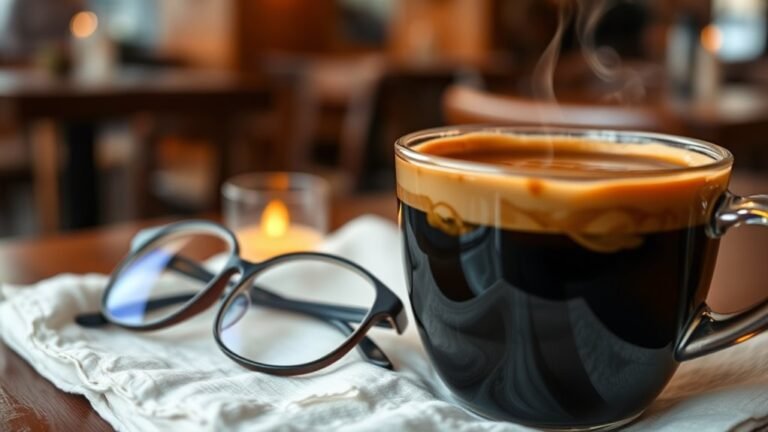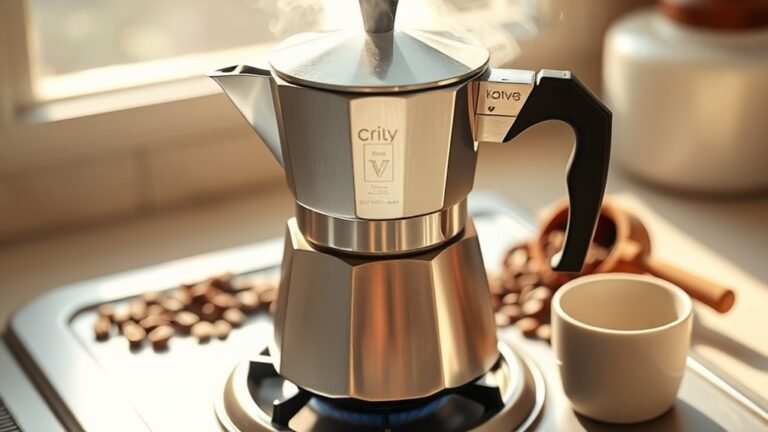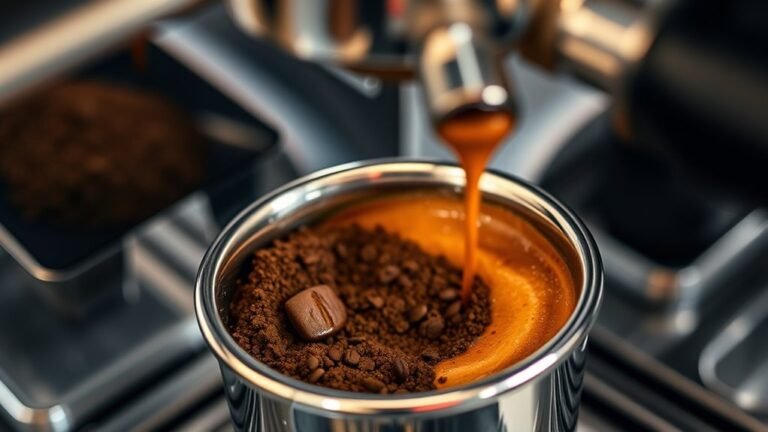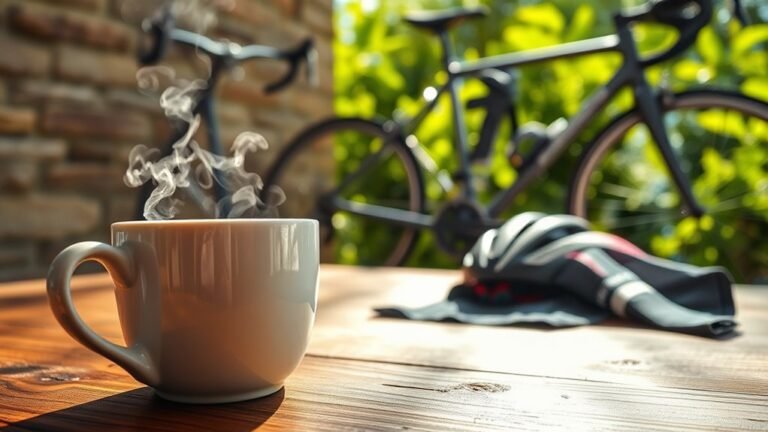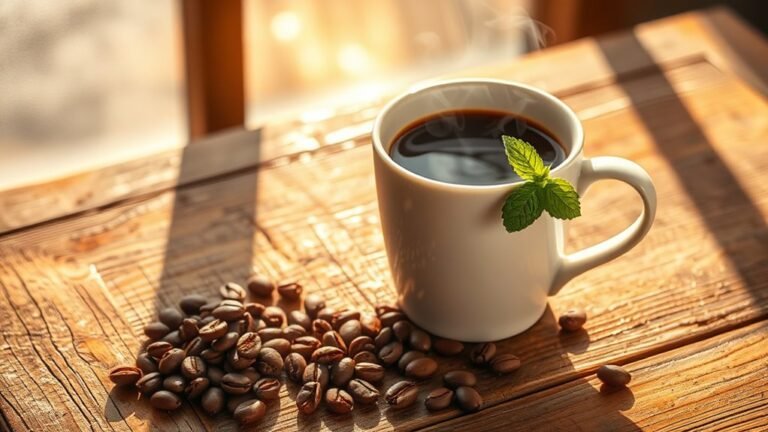The Golden Cup Standard: A Guide to Brewing Perfect Coffee
The Golden Cup Standard helps you brew coffee that’s perfectly balanced in flavor, aroma, and strength by focusing on precise parameters like water temperature (195-205°F), coffee-to-water ratio (about 18-20g per 300ml), and grind size. By selecting quality beans and using clean water, you control extraction to avoid bitterness or weakness. Master your equipment and technique to reveal rich, consistent brews. Keep exploring these essentials to elevate every cup you make.
Understanding the Golden Cup Standard

The Golden Cup Standard is your benchmark for brewing coffee that consistently delivers balanced flavor, aroma, and strength. It’s rooted in brewing science, defining precise parameters—like water temperature, coffee-to-water ratio, and extraction time—that maximize coffee flavor without bitterness or weakness. By adhering to these guidelines, you gain freedom from guesswork, ensuring each cup meets a reliable quality threshold. Understanding this standard empowers you to control every variable, crafting coffee that reflects your taste preferences with clarity and precision. The standard isn’t a limitation but a foundation, enabling you to explore and perfect your brewing technique. Embracing it transforms coffee-making into a deliberate, passionate craft, where every sip celebrates the harmony of science and flavor you seek.
The History Behind the Golden Cup Standard
Although you might take the Golden Cup Standard for granted today, its development was a careful response to decades of inconsistent brewing practices and subjective taste preferences. As coffee quality became a global concern, experts sought a universal benchmark to liberate brewers from guesswork. The brewing evolution unfolded through:
- Rigorous scientific research identifying ideal extraction levels.
- Collective agreement among coffee professionals emphasizing reproducibility.
- The desire to empower every individual to brew with confidence and freedom.
This standard revolutionized how you experience coffee, transforming it from a hit-or-miss ritual into a precise craft. Understanding its history helps you appreciate the meticulous effort behind every perfect cup, ensuring that your journey toward coffee freedom is rooted in reliable, evidence-based principles rather than fleeting trends or personal biases.
Key Parameters That Define the Standard
Understanding the history behind the Golden Cup Standard gives you a solid foundation to grasp what makes a perfect brew. The key parameters revolve around precise brewing variables and ideal extraction time, ensuring balance and clarity in every cup. You’ll want to control grind size, water temperature, and contact time carefully. Extraction time is vital—it influences flavor intensity and avoids bitterness or under-extraction. The table below highlights essential parameters and their ideal ranges:
| Parameter | Ideal Range | Effect on Brew |
|---|---|---|
| Water Temperature | 195°F – 205°F (90-96°C) | Extracts soluble flavors |
| Grind Size | Medium to medium-fine | Controls extraction rate |
| Extraction Time | 4-6 minutes | Balances flavor clarity |
Mastering these lets you brew coffee that’s truly free and delicious.
Choosing the Right Coffee Beans

When selecting coffee beans, you need to take into account how the origin shapes flavor profiles, from bright and fruity to rich and earthy. Equally important is choosing the roast level that complements your brewing method and personal taste, whether you prefer light, medium, or dark. These choices directly impact the balance and intensity of your final cup.
Bean Origin Impact
The origin of your coffee beans plays an essential role in shaping the flavor profile you’ll experience in your cup. When you understand how bean varietals influence taste, you gain the freedom to select coffees that resonate with your palate. Regional flavor profiles are not just labels—they’re maps to unique sensory journeys. Consider these distinctions:
- Ethiopian beans often offer floral and citrus notes, bright and vibrant.
- Colombian coffee typically delivers balanced, nutty, and chocolate undertones.
- Indonesian varieties bring earthy, bold, and sometimes spicy characteristics.
Choosing beans from different origins lets you explore diverse expressions of coffee. You’re not just brewing a drink—you’re embracing a world of flavor possibilities, guided by the geography and genetics of the beans themselves. This awareness empowers you to craft your perfect cup every time.
Roast Level Selection
Although bean origin shapes flavor, roast level dramatically defines the final character of your coffee. Choosing between light roasts and dark roasts determines your coffee’s flavor profiles, roast intensity, and coffee aroma. Light roasts preserve origin nuances and highlight bright tasting notes, while dark roasts emphasize roast development and bold, smoky flavors. Always prioritize roast freshness to capture peak aroma and complexity.
| Roast Level | Flavor Profiles | Tasting Notes |
|---|---|---|
| Light Roasts | Fruity, floral, acidic | Citrus, berry, floral |
| Medium Roasts | Balanced, sweet | Caramel, nutty, chocolate |
| Dark Roasts | Bold, smoky, intense | Cocoa, toasted, spicy |
Select your roast level to match your freedom in flavor exploration and brewing style.
The Importance of Water Quality and Temperature

You can’t underestimate how water quality shapes your coffee’s flavor—impurities or minerals can drastically alter the taste. Getting the temperature just right, usually between 195°F and 205°F, guarantees ideal extraction without bitterness. Mastering these factors will transform your brew from ordinary to exceptional.
Optimal Water Temperature
How hot should your water be to release the full flavor of your coffee beans? Striking the perfect temperature is essential because it directly affects water solubility and brewing chemistry. Too cool, and you under-extract, leaving flavors muted. Too hot, and you risk over-extraction, making your cup bitter.
Aim for:
- 195°F to 205°F (90°C to 96°C) — the sweet spot where compounds dissolve efficiently.
- Consistency — fluctuating temps disrupt extraction balance.
- Immediate use — water cooling below this range weakens solubility and flavor release.
Mastering this range lets you reveal coffee’s vibrant freedom in every cup. You’re no longer just brewing; you’re orchestrating a precise chemical dance that celebrates your beans’ essence with every sip.
Water Purity Effects
Because water makes up over 98% of your coffee, its purity profoundly shapes the final flavor. You can’t overlook water filtration—it removes impurities that dull your brew’s clarity. But mineral content also plays a crucial role; minerals help extract the coffee’s nuanced flavors without overpowering them. Too few minerals, and your coffee tastes flat; too many, and it becomes harsh. Temperature works hand-in-hand with purity, revealing flavors only clean water can expose.
| Factor | Impact |
|---|---|
| Water Filtration | Removes contaminants, enhances clarity |
| Mineral Content | Balances extraction, enriches flavor |
| Temperature | Activates aroma and taste compounds |
| Purity | Guarantees crisp, clean, vibrant cup |
Mastering water purity lets you brew with freedom—creating coffee that’s authentically yours.
Grinding Coffee for Optimal Extraction

Grinding coffee is the essential step that reveals the beans’ full flavor potential. To master grinding techniques, you must understand how grind size controls extraction and taste. Here’s how to take charge:
Grinding unlocks coffee’s true flavor by controlling extraction through precise grind size mastery.
- Coarse Grind: Ideal for French press, letting water flow freely for a bold, rich cup.
- Medium Grind: Perfect for drip machines, balancing extraction speed and flavor clarity.
- Fine Grind: Used for espresso, maximizing surface area to release intense aromas swiftly.
Adjusting grind size empowers you to control extraction, avoiding bitterness or sourness. Remember, freshness matters—grind just before brewing to capture vibrant, nuanced flavors. With the right grind, your coffee becomes a canvas where freedom meets precision, revealing every note the bean has to offer. Embrace grinding as your gateway to coffee liberation.
Brewing Methods That Meet the Standard
You’ll want to choose brewing methods that consistently deliver balanced flavor and proper extraction. From pour-over to French press, each technique requires specific equipment that influences the final cup. Understanding these methods and tools guarantees your coffee meets the highest standards every time.
Popular Brewing Techniques
While there are countless ways to brew coffee, certain methods consistently deliver the rich, balanced flavors that coffee lovers crave. To master your craft, focus on how brew time and extraction time shape your cup. Here are three popular techniques that meet the golden cup standard:
- Pour-over – You control brew time precisely, pouring hot water over grounds in a slow, circular motion, allowing ideal extraction.
- French press – With a longer extraction time, immersion brewing brings out deep, bold flavors and fuller body.
- Aeropress – Combining pressure and variable brew time, it gives you freedom to experiment with strength and clarity.
Each method empowers you to release coffee’s potential, delivering freedom to tailor every cup perfectly to your taste.
Equipment for Quality Brewing
Because the right equipment directly influences extraction and flavor clarity, selecting quality brewing tools is essential for crafting your ideal cup. When choosing brewing devices, prioritize those that allow precise control over temperature, grind size, and brew time—key factors that reveal coffee’s full potential. Whether you favor a pour-over, French press, or espresso machine, each device demands specific coffee accessories like scales, grinders, and filters to maintain consistency and precision. Investing in reliable equipment not only elevates your brew but also grants you the freedom to experiment and refine your technique. Remember, your brewing setup shapes every sip; choosing the right tools empowers you to meet the Golden Cup Standard and savor coffee exactly how you want it.
Measuring Coffee-to-Water Ratios Accurately
How much coffee you use compared to water can make or break your brew. To seize full control over your coffee’s flavor, you need to measure precisely. Relying on coffee scales rather than just measuring spoons frees you from guesswork and inconsistency. Here’s how you can master your coffee-to-water ratio:
- Weigh your coffee beans using a coffee scale for accuracy, aiming for about 18-20 grams per 300 ml of water.
- Measure water with a precise container or scale to maintain consistency.
- Adjust ratios based on strength preference, knowing small tweaks profoundly affect taste.
Tools and Equipment to Achieve the Golden Cup
Even if you master your coffee-to-water ratio, the right tools can elevate your brew from good to exceptional. Selecting quality brewing accessories and reliable coffee scales lets you control every variable, releasing freedom in your craft. Here’s a quick overview of essential equipment:
| Equipment | Purpose | Benefit |
|---|---|---|
| Coffee Scales | Measure precise ratios | Consistency and accuracy |
| Burr Grinder | Uniform grind size | Enhanced extraction |
| Pour-over Kettle | Controlled water flow | ideal brewing temperature |
Investing in these lets you fine-tune your process, ensuring each cup meets the Golden Cup standard. Remember, precision tools empower you to explore flavors confidently, making your perfect coffee a repeatable achievement every time.
Tips for Consistently Brewing the Perfect Cup

When you aim for consistency in brewing, attention to detail becomes your greatest ally. To master brewing consistency and release vibrant flavor profiles, focus on these key tips:
- Measure Precisely: Use a scale to weigh your coffee and water. Precision guarantees each cup mirrors your desired strength and taste.
- Control Water Temperature: Keep water between 195°F and 205°F. This range extracts ideal flavors without bitterness.
- Standardize Grind Size: Adjust your grinder for a uniform particle size. It controls extraction speed, directly impacting flavor clarity.
Frequently Asked Questions
Can the Golden Cup Standard Be Applied to Instant Coffee?
Imagine your coffee as a canvas—instant coffee quality sets the base colors, while brewing techniques add the brushstrokes. You can apply the Golden Cup Standard’s principles to instant coffee, but with some limits since instant lacks the freshness whole beans offer. Still, by refining water temperature and ratio, you enhance flavor and clarity. So yes, you’re free to elevate instant coffee, but expect a different masterpiece than freshly brewed.
How Does Altitude Affect Brewing to the Golden Cup Standard?
When brewing at higher altitudes, you’ll notice water boils at lower temperatures due to altitude variations, which affects extraction. You’ll need to adjust your brewing techniques—like increasing brew time or slightly raising water temperature—to compensate. This guarantees you extract the coffee’s full flavor without under-extracting. Embracing these adjustments lets you maintain balance and clarity in your cup, regardless of elevation, freeing you to craft perfection anywhere you choose.
Is Decaffeinated Coffee Compatible With the Golden Cup Standard?
Did you know that decaf coffee retains up to 97% of its original caffeine content depending on the process? When you’re focused on decaf brewing, preserving the flavor profile is key. You can absolutely achieve a satisfying cup by adjusting grind size, water temperature, and brew time to enhance decaf’s subtle nuances. With the right technique, your decaf coffee can taste just as rich and vibrant, giving you the freedom to enjoy quality without compromise.
What Is the Environmental Impact of Following the Golden Cup Standard?
When you follow the Golden Cup Standard, you’re embracing sustainable sourcing, which helps protect coffee-growing regions and supports ethical farming. You’re also committed to waste reduction by measuring ingredients precisely, avoiding excess coffee grounds and water. This approach not only elevates your brew but minimizes your environmental footprint, letting you enjoy freedom in your coffee ritual while honoring the planet. It’s a simple way to make your daily cup more responsible and impactful.
Can Flavored Coffee Beans Meet the Golden Cup Standard?
You can enjoy flavored coffee beans and still aim for excellent flavor extraction, but it’s tricky. The added flavors can mask the true bean quality, making it harder to evaluate purity and balance. If you value freedom in your brew, choose high-quality beans first; then, flavored varieties can be an adventurous twist. Just remember, the original bean’s excellence sets the foundation for a perfect cup, flavored or not.

